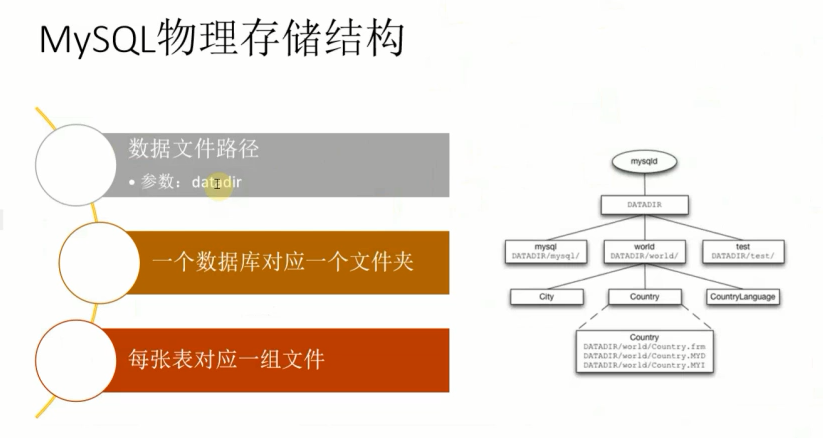本文主要给大家介绍自定义mysql-5.5.56版的安装路径讲义,希望可以给大家补充和更新些知识,如有其它问题需要了解的可以持续在亿速云行业资讯里面关注我的更新文章的。
安装路径:/application/mysql-5.5.56
libaio
yum install -y libaio
useradd -s /bin/false -M mysql
cd /tools wget https://dev.mysql.com/get/Downloads/MySQL-5.5/mysql-5.5.56-linux-glibc2.5-x86_64.tar.gz tar -zxf mysql-5.5.56-linux-glibc2.5-x86_64.tar.gz -C /application/
cd /application/ mv mysql-5.5.56-linux-glibc2.5-x86_64/ mysql-5.5.56 ln -s mysql-5.5.56/ mysql

chown -R mysql:mysql mysql-5.5.56/
cd mysql
会在mysql目录内生成一个data目录,存放数据库的目录
./scripts/mysql_install_db --basedir=/application/mysql --datadir=/application/mysql/data/ --user=mysql
chown -R root . chown -R mysql data
除了mysql目录下的data目录所属用户不变,其他所有文件的所属用户改为root
cp support-files/my-medium.cnf /etc/my.cnf
将mysql的配置文件拷贝为/etc/目录下的my.cnf
sed -i 28i'log-error=/application/mysql/data/mysqld.error' /etc/my.cnf
在配置文件插入了一行,进行配置错误日志
/etc/my.cnf Content:
# Example MySQL config file for medium systems. # # This is for a system with little memory (32M - 64M) where MySQL plays # an important part, or systems up to 128M where MySQL is used together with # other programs (such as a web server) # # MySQL programs look for option files in a set of # locations which depend on the deployment platform. # You can copy this option file to one of those # locations. For information about these locations, see: # http://dev.mysql.com/doc/mysql/en/option-files.html # # In this file, you can use all long options that a program supports. # If you want to know which options a program supports, run the program # with the "--help" option. # The following options will be passed to all MySQL clients [client] #password = your_password port = 3306 socket = /tmp/mysql.sock # Here follows entries for some specific programs # The MySQL server [mysqld] port = 3306 log-error=/application/mysql/data/mysqld.error socket = /tmp/mysql.sock skip-external-locking key_buffer_size = 16M max_allowed_packet = 1M table_open_cache = 64 sort_buffer_size = 512K net_buffer_length = 8K read_buffer_size = 256K read_rnd_buffer_size = 512K myisam_sort_buffer_size = 8M # Don't listen on a TCP/IP port at all. This can be a security enhancement, # if all processes that need to connect to mysqld run on the same host. # All interaction with mysqld must be made via Unix sockets or named pipes. # Note that using this option without enabling named pipes on Windows # (via the "enable-named-pipe" option) will render mysqld useless! # #skip-networking # Replication Master Server (default) # binary logging is required for replication log-bin=mysql-bin # binary logging format - mixed recommended binlog_format=mixed # required unique id between 1 and 2^32 - 1 # defaults to 1 if master-host is not set # but will not function as a master if omitted server-id = 1 # Replication Slave (comment out master section to use this) # # To configure this host as a replication slave, you can choose between # two methods : # # 1) Use the CHANGE MASTER TO command (fully described in our manual) - # the syntax is: # # CHANGE MASTER TO MASTER_HOST=<host>, MASTER_PORT=<port>, # MASTER_USER=<user>, MASTER_PASSWORD=<password> ; # # where you replace <host>, <user>, <password> by quoted strings and # <port> by the master's port number (3306 by default). # # Example: # # CHANGE MASTER TO MASTER_HOST='125.564.12.1', MASTER_PORT=3306, # MASTER_USER='joe', MASTER_PASSWORD='secret'; # # OR # # 2) Set the variables below. However, in case you choose this method, then # start replication for the first time (even unsuccessfully, for example # if you mistyped the password in master-password and the slave fails to # connect), the slave will create a master.info file, and any later # change in this file to the variables' values below will be ignored and # overridden by the content of the master.info file, unless you shutdown # the slave server, delete master.info and restart the slaver server. # For that reason, you may want to leave the lines below untouched # (commented) and instead use CHANGE MASTER TO (see above) # # required unique id between 2 and 2^32 - 1 # (and different from the master) # defaults to 2 if master-host is set # but will not function as a slave if omitted #server-id = 2 # # The replication master for this slave - required #master-host = <hostname> # # The username the slave will use for authentication when connecting # to the master - required #master-user = <username> # # The password the slave will authenticate with when connecting to # the master - required #master-password = <password> # # The port the master is listening on. # optional - defaults to 3306 #master-port = <port> # # binary logging - not required for slaves, but recommended #log-bin=mysql-bin # Uncomment the following if you are using InnoDB tables #innodb_data_home_dir = /usr/local/mysql/data #innodb_data_file_path = ibdata1:10M:autoextend #innodb_log_group_home_dir = /usr/local/mysql/data # You can set .._buffer_pool_size up to 50 - 80 % # of RAM but beware of setting memory usage too high #innodb_buffer_pool_size = 16M #innodb_additional_mem_pool_size = 2M # Set .._log_file_size to 25 % of buffer pool size #innodb_log_file_size = 5M #innodb_log_buffer_size = 8M #innodb_flush_log_at_trx_commit = 1 #innodb_lock_wait_timeout = 50 [mysqldump] quick max_allowed_packet = 16M [mysql] no-auto-rehash # Remove the next comment character if you are not familiar with SQL #safe-updates [myisamchk] key_buffer_size = 20M sort_buffer_size = 20M read_buffer = 2M write_buffer = 2M [mysqlhotcopy] interactive-timeout
cp support-files/mysql.server /etc/init.d/mysql
将mysql的启动程序拷贝到/etc/init.d/目录下,以便启动程序
方法一:
思路是给配置文件提供的变量进行赋值。较麻烦。
sed -i ':a;N;$!ba;s/basedir=\ndatadir=/basedir=\/application\/mysql\ndatadir=\/application\/mysql\/data/g' /etc/init.d/mysql sed -i ':a;N;$!ba;s/mysqld_pid_file_path=\n/mysqld_pid_file_path=\/application\/mysql\/data\/mysqld.pid\n/g' /etc/init.d/mysql
等价于将45、46两行
basedir= datadir= mysqld_pid_file_path= 替换成 basedir=/application/mysql datadir=/application/mysql/data mysqld_pid_file_path=/application/mysql/data/mysql.pid
方法二(推荐):
思路是将脚本的默认地址(/usr/local/mysql)直接替换成自定义路径(/application/mysql),便不用给变量赋值
sed -i 's#/usr/local/mysql#/application/mysql#g' /etc/init.d/mysql
到这里mysql安装完成可以正常启动
将mysql命令创建软链接到环境变量的目录,使用户可以在变量找到相应的命令
ln -s /application/mysql/bin/* /usr/local/sbin
第一次设置密码:
mysqladmin -u'<User>' password '<PassWord>'
例子:
mysqladmin -u'root' password 'PassWord'
往后修改密码:
mysqladmin -u'<User>' -p'<OldPassWord>' password '<NewPassWord>'
例子:
mysqladmin -u'root' -p'PassWord' password 'NewPassWord'
[root@www mysql]# mysql -u'root' -p'PassWord' Welcome to the MySQL monitor. Commands end with ; or \g. ... mysql> #成功登陆到mysql控制台 [root@www mysql]# mysql -uroot -pPassWord Welcome to the MySQL monitor. Commands end with ; or \g. ... mysql> #成功登陆到mysql控制台 [root@www mysql]# mysql -u'root' -p Enter password: #这里输入用户的密码 Welcome to the MySQL monitor. Commands end with ; or \g. ... mysql> #成功登陆到mysql控制台 [root@www mysql]# mysql -uroot -p Enter password: #这里输入用户的密码 Welcome to the MySQL monitor. Commands end with ; or \g. ... mysql> #成功登陆到mysql控制台
mysql> quit Bye [root@www mysql]# or mysql> ^DBye [root@www mysql]#
mysql -u'root' -p'PassWord' mysql -uroot -pPassWord mysql -u'root' -p mysql -uroot -p
service mysql start
service mysql stop
service mysql restart
看了以上关于自定义mysql-5.5.56版的安装路径讲义,希望能给大家在实际运用中带来一定的帮助。本文由于篇幅有限,难免会有不足和需要补充的地方,如有需要更加专业的解答,可在官网联系我们的24小时售前售后,随时帮您解答问题的。
免责声明:本站发布的内容(图片、视频和文字)以原创、转载和分享为主,文章观点不代表本网站立场,如果涉及侵权请联系站长邮箱:is@yisu.com进行举报,并提供相关证据,一经查实,将立刻删除涉嫌侵权内容。